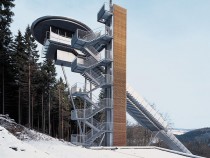
© Stefan Schilling
A decision was made to demolish the existing ski-jumping facilities, which no longer met modern requirements, and to erect a new ski jump within a year, before the next contest in February 2001. In addition to creating a geometry that would reflect present-day techniques in this sport, a stadium was required with space for 38,000 spectators. In view of the short construction period, the work was divided into a number of stages that could be executed parallel to each other. Questions relating to jumping and production techniques were clarified on site with the help of a full-size model of the actual track along the gradient. Based on?calculations, this three-dimensional line determined the form of the ski jump. The next step comprised laying the foundations and erecting the lower part of the ramp – the section in contact with the ground – as well as the lift tower and the structures at the head of the jump. At the same time, two other sections of the structure were prefabricated: the ski jump tower with its glazed canopy, and the upper part of the ramp – a slenderly dimensioned steel structure. The load-bearing members along the steepest part of the ramp, including the transparent wind-protection, were attached at right angles, thereby reducing the amount of site welding. The prefabricated steel structure was transported to the site on heavy-duty lorries for preassembly. It was then hoisted on to the previously erected columns and rigidly fixed to the lift tower, which serves as a means of bracing.



